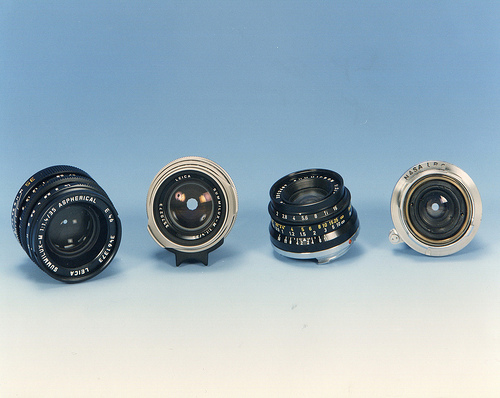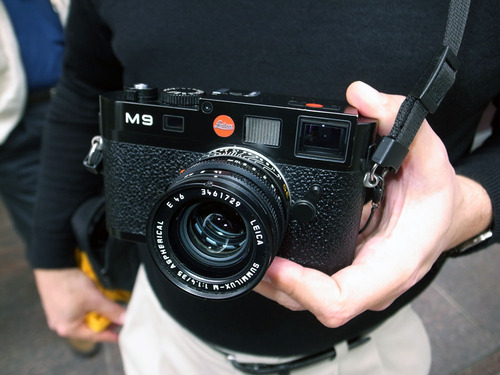Summilux-M 35 mm f:1,4 Aspherical
Características
Código - 11 873 LLC - 157
Producción - 1991-1994 < 4,000 ejemplares
Montura - Bayoneta Leica M
Angulo de visión diagonal, horizontal, vertical: - Para 35 mm: 64°, 54°, 38°Diseño Óptico:
Número de lentes/grupos 9 / 5, una asférica, con dos superficies asféricas
Longtud focal efectiva - 35.6 mm
Posición de la pupila de entrada 6.8 mm (respecto a la primera superficie de lente en la dirección de la luz)
Intérvalo de enfoque: - 0.7 m a infinito
Escalas: combinada, metros/pies
Campo visual mínimo: 420 mm x 630 mm
Factor de reproducción: - 1:17.5
Diafragma - f/1.4-f/16 con click, valores intermedios, diafragma manual tipo iris de 10 hojas
Montura de flitros: roscado interno para filtros E-46, elemento frontal no rotatorio.
Parasol: Separado, encajado, con seguro, incluido en el paquete original.
Accesorios - Parasol: 12587 o 12588
Visor: incluido en la cámara
Longitud hasta la bayoneta - ap 34.5 mm
Diámetro máximo - ap 53 mm
Peso - aprox. 300 g
Materiales - Aluminio anodizado y vidrio óptico
Inscripción - LEICA SUMMILUX-M 1:1.4/35 ASPHERICAL E46 3XXXXXX
Diseño - Walter Watz - 15 Feb 1991
Referencias
Descripción
El diseño óptico no es un trabajo cotidiano, sino un arte en el que la idea genial es tan importante como el dominio de las ecuaciones matemáticas. La validez de esta regla puede haaberse demostrado por Walther Watz, el diseñador del Summilux-M 1:1.4/35 mm aspherical.
Durante décadas el diseño Doble-Gauss había sido el esquema preferido para los objetivos luminosos en una amplia gama de longitudes focales. Research in the Leitz optical department made it clear that substantial improvement of image quality asked for a new approach. The DG-type has a symmetrical construction with a converging lens (+)-diverging lens (-) -stop-diverging lens (-)- converging lens (+) sequence. The new approach added to this sequence (+ - - + ) two lenses with negative powers (diverging) to become - (+ - - +) -, giving the designer much more power to correct the aberrations. It is simple, but as always with brilliant ideas with hindsight it is obvious. The design goal was to significantly enhance the image quality in the field, while keeping the physical volume small: the total length is a mere 44.5 mm.
The lens employs two aspherical surfaces manufactured with a method that was technically closely related to the method used for the aspherical surfaces of the Noctilux 1.2/50mm. The production started around 1988 and the lens was introduced in January 1990. Leitz announced that it was a special edition next to the regular Summilux-M 1.4/35 mm and should be available in the second quarter of 1990 in a limited edition of 2000 units. The lens was costly to produce, but the superior performance soon was an open secret and demand was high enough for two more batches to be allocated with a total of more than 4000 units.
The Summilux-M 1:1.4/35 mm aspherical is generally two stops ahead of the Summilux from 1961. At 1:2 it is better than the older one at 1:5.6. It is a lens with very high contrast and excellent definition at all apertures. This high performance already at maximum aperture was ideally suited to slide film emulsions, producing natural colors with good saturation even in poor light situations. The lens is also famous for its subtle recording of the depth impression of the subject, producing pictures with excellent three-dimensionality.
This lens is fully absorbed into the collector scene and will be very difficult to find and extremely expensive. For the working photographer the recently introduced SX 35 ASPH FLE is the better option and this lens even has better performance.
Two Leica 35mm Summilux, a Leitz 35 Summicron and a NASA-Leitz 35 Summicron por tango-, en Flickr
Steve Huff
Tokyo Camera Style. Ginza. Leica M9 with 35mm f1.4 Summilux-M Aspherical...
Ésta página ha sido vista 3.160 veces
-
-
Creado por elultima actualización por , el
-



